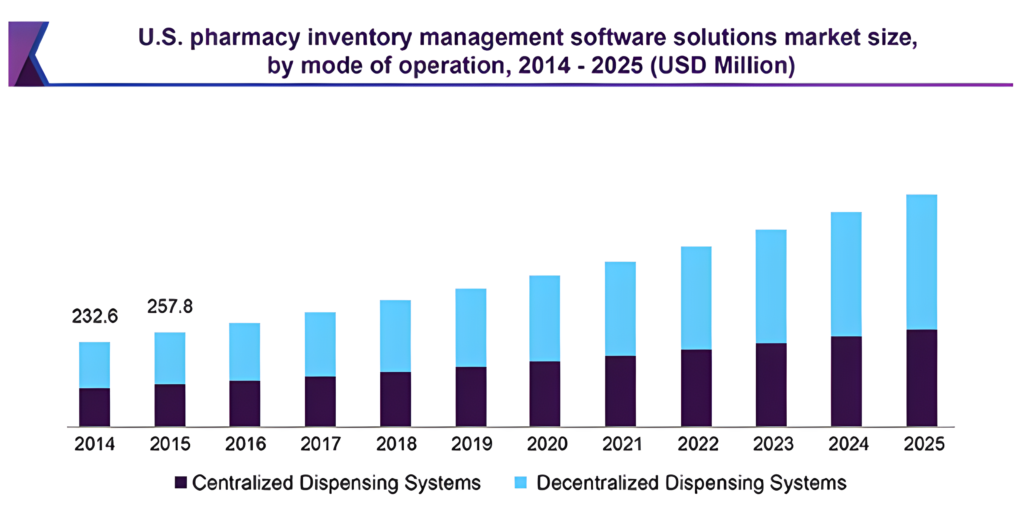Dec 18, 2023 Software Development
How To Develop A Pharmacy Management Software – Features, Process, Costs

Is the endless paperwork, messy pharmacy inventory, and slow process in your pharmacy store making you weary? Do not look anymore, because with powerful management software, you can now master pharmacy operations. This is the latest technology that is transforming the working of the various pharmacies in the country into being more efficient, organized, and profit-making. But, what is pharmacy management software and how can it be of help to your business? This blog post explores the essential elements, creation procedures, and expenses associated with the development of pharmacy management software. We shall walk you through the benefits and costs involved in this endeavor.
Understanding Pharmacy Management Software: An Overview
Pharmacy management software is one of the most powerful tools that is transforming how pharmacies run. This is a comprehensive solution that automates all the day-to-day operations of a pharmacy towards enhancing profits.
In general, Pharmacy management software is the brain of pharmacy operations. It consists of various elements, which make processes like inventory management, billing insurance claims, prescription processing, patient profiles, and so on, easier and automated. All these functions are integrated into a single platform, thus getting rid of manual paperwork and errors as well as enhancing efficiency.
Pharmacy management software is a good way to track inventory. This software helps pharmacies accurately keep track of the quantities of available medications and their expiry dates as well as reorder points. Additionally, it prevents stockout which is essential to a uniform stock of medicaments saving time and money.

Additionally, pharmacy management software improves customer service by making patient information and drug history readily accessible to pharmacists. It helps them to give each patient individual attention, detect drug allergies or interactions, or provide medication counseling. It also facilitates communication with healthcare providers for e-Rx/ e-Refill. This enables the processes to be more efficient, and it reduces the risk of transcription errors, thus protecting the patients.
Key Features of Efficient Pharmacy Management Software
It has many features that are designed to enhance your pharmacy operations. Keeping this in mind, let us now examine the main attributes that make this software very potent.
1. Inventory Management
Keep in mind your inventory levels, expiration dates, and times for reordering to track your drug supply. This is a key attribute since you are guaranteed that you will always have the essential drugs, and it assists in avoiding stockouts.
2. Prescription Processing
Process prescriptions seamlessly and efficiently. One of the features of the system enables you to order, confirm, and prescribe drugs at a lower error rate and in less time.
3. Billing and Insurance Claims
Built-in billing & insurance claims for streamlined billing. Provide accurate bills, electronically file claims, and ease reimbursements.
4. Patient Profiles
Fast patient data retrieval involving medication histories, allergies, and preferences. This helps you to customize care and improve patient safety.
5. Medication Interactions
The aim is to identify drug allergies and potential interactions of the drugs for enhanced safety of the patient. This element warns pharmacists that there is a likelihood of risk, allowing adequate medication counseling.
6. Electronic Prescribing
Increase communications with providers on e-prescribing. Such features include the elimination of handwritten prescriptions and transcription errors.
7. Electronic Refill Requests
Make it easier for patients to request refills electronically, which the patients should be able to do. This is more convenient for the patient since he saves time and the overall efficiency is higher.
8. Reporting and Analytics
Deep reporting and analytics tools will help you get new ideas in analyzing your pharmacy. These include tracking sales, analyzing inventory trends, and identifying problem areas.
9. Drug Database Integration
A complete drug database for verifying and confirming proper drug dosage for dispensing.
10. Workflow Automation
Improving productivity through automation of work routines and workflows. It is effective, fast, and minimizes error.
11. Compliance Monitoring
Compliance and monitoring of compliance concerning regulatory requirements. In other words, the pharmacy should comply with the regulations of the regulators.
12. Document Management
The process of scanning, digitizing, and organizing prescriptions, medical records, and insurance information. This element cuts down on paperwork making the organization easier.
13. Patient Communication
Text automated messages to patients reminding them about refills and pick-up. Patient engagement and fostering medication adherence are possible through this.
14. Integration with other Systems
It should be compatible with other healthcare systems such as EHRs and PBMs. It facilitates communication and cooperation.
Detailed Process of Developing Pharmacy Management Software
However, it is a careful and strategic process to develop pharmacy management software. There are many important stages in this process, all of which are essential to creating a potent instrument that has the potential to transform how pharmacies operate. The development of pharmacy management software requires a lot of steps which are crucial for the system.
- Requirements Gathering: First, the gathering of requirements from the pharmacy owners and other stakeholders. This entails knowing what the consumers require, what they are experiencing, and what they require in the software system. To ensure that the software suits their goals, they need to know the pharmacy’s workflows, processes, and objectives.
- System Design: After that gathering requirements followed by designing the system architecture and user interface. This involves coming up with an outline of how the software will work, consisting of modules, screens, and functions. It should be friendly to the user, easy to use, and efficient.
- Database Design: The robust and scalable database is used by the pharmacy management software to carry out the storage and management of information. Such information includes drug details, patient profiles, inventory records, and many more. Database design consists of organizing the data, designing tables, forming relations, and upholding data consistency.
- Development: The development stage commences with a design and a database available. The code that makes the software come alive is written by professional software engineers and developers. In the process, they use programming languages, frameworks, and libraries to implement the multiple features and functionalities identified in the requirements-gathering phases. The software is thoroughly tested and debugged in this phase to work error-free.
- Integration and Testing: At the end of the development cycle, the software is made compatible with other information systems such as EHRs and PBMs. This promotes the flow of information and fosters teamwork. The software is subjected to rigorous testing at every integration point to guarantee it works properly and satisfies all specified requirements.
- Deployment and Training: The pharmacy management software can be launched after extensive testing. The software is installed into the pharmacy’s hardware, and the pertinent adjustments are made to allow for smooth operations. Afterward, pharmacy staff are provided with training on entering patient records, management of stocks, dispensing prescriptions, and producing reports.
Estimating the Costs of Pharmacy Management Software Development
Implementing a pharmacy management software system in your pharmacy could be cost-prohibitive and time-consuming. However, there are some things to take into account when calculating the budget required for the pharmacy management software development.
- Scope and Complexity: Depending on the scope and complexity of the project, the development cost for pharmacy management software varies greatly. The more you add the functionality of features, the more it will cost to develop. The topics of customization, integration with other systems, and user-friendliness can also contribute to the overall cost.
- Development Team: The cost is also affected by the experience and expertise of the development team. They often cost more since they are expert code producers and programmers who manufacture impressive, solid, and effective software. This will also vary depending on the number of developers and the time taken to complete development.
- Design and User Experience: The overall software efficiency depends on the interface design and usability. Investing in superior UX/UI design, which helps work with ease and promotes higher consumer satisfaction is a worthy decision. However, this might increase the development costs.
- Technology Stack: Another consideration is that technology stack selection contributes to the development cost as well as the ongoing maintenance cost. Costs of development and licensing of various programming languages, frameworks, and libraries. Choose a tech stack that meets your requirements and your pocket.
- Testing and Quality Assurance: Wide-ranging testing and quality assurance are crucial, to ensure that there are no glitches in the software. The overall test entails finding and fixing bugs to increase performance and reduce vulnerability. However, additional testing will increase the overall development costs.
- Ongoing Support and Maintenance: After that, the developed software also has to be supported and maintained. Such problems concern bug fixes, updates, and upgrades. Account for the longer-term costs of support and maintenance when estimating the total costs of developing pharmacy management software.
It is difficult to give a precise price that does not include the details of the project requirements; it may cost about $ 50,000 -$ 200,000 or more. You should work with a credible mobile app development company that can give you specific costing aligned to your project demands.
Maximizing Efficiency and Profitability through Effective Pharmacy Management Software
Efficiency and profitability remain critical to most pharmacies in today’s highly competitive healthcare environment. It’s here that efficient pharmacy management software is a must. Technology can help optimize the routine activities in a pharmacy which in a nutshell will enhance productivity.
Pharmacy management software increases efficiencies by simplifying workflow processes and automating tasks that can be repeated. This minimizes paperwork and greatly reduces the chances of mistakes. It enables pharmacies to save time, increase accuracy, and increase efficiency by offering features such as inventory management, prescription processing, billing, and insurance claims. This implies that more time will be devoted to giving quality health care and less time wasted doing clerical work.
Effective pharmacy management software allows easy interaction between the pharmacy and healthcare providers. Electronic prescribing and refill requests help boost efficiency as well as improve patient safety by minimizing the risk of transcription mistakes. Additionally, the software provides easy access to patient’s information and medication history, which pharmacists use to offer personalized care and identify potential drug interactions or allergies. This high standard of patient-oriented service not only boosts patient satisfaction but also results in better compliance with treatment regimes.
Pharmacy management software also maximizes efficiency in reporting and analytics. Pharmacies can monitor sales, track trends in inventory, and find areas for improvement by making use of data. In addition, this improves profitability among the pharmacies to ensure that they are also meeting regulatory requirements and remaining compliant.
Therefore, efficient Pharmacy Management Software represents a breakthrough for pharmacies aiming to enhance operational effectiveness and revenue. This strong tool ensures the efficiency of processes, improves communication, and offers vital information through which pharmacies get to the higher plane. Enrolling a suitable pharmacy management software is investing in the future success of your pharmacy.
Conclusion
Keeping abreast with the current market trends in this very aggressive industry calls for appropriate instruments and tactics. The pharmacy management software could become a real turning point for your working pharmacy, which will make all your internal processes more effective, systematized, and, as a result, much more commercially successful. This powerful tool enables pharmacies to elevate their operations by automating processes, improving communication, and offering important insights.
It is important to choose a trusted software development partner for this purpose because you need to create pharmacy management software that fits your unique set of needs and goals. Hiring a reputable mobile app development company with a specialization in developing pharmacy management software is worthwhile as the software must be customized to meet your specific needs and aimed to improve your overall effectiveness and profitability. Buying pharmacy management software is an investment in the future success of your pharmacy. This is because this not only saves time and cuts down on errors but also assists in improving patient care, ensuring patient safety as well as compliance with the regulations. So why wait? Engage a qualified mobile app developer today to boost your pharmacy business. Beat the competition, improve your processes, and take your pharmacy to the next level of success.
FAQ
1. Can I customize pharmacy management software to suit my pharmacy?
Absolutely, pharmacy management software could be adjusted to fit your specific pharmacy requirements. Working in close contact with a software development partner, you can discuss the details of what has to be done or should be there. They will ensure that the software fits within the needs and aspirations of your pharmacy.
2. What is the time used in developing pharmacy management software?
The development of pharmacy management software can take different periods depending on the scale and nature of the project. They usually span months if not a year. It comprises aspects like collecting demands, designing a system, designing a database, creating, assimilation, deploying, and sustaining operations.
3. Is pharmacy management software interoperable with other healthcare systems?
Integration of pharmacy management software with existing systems is possible with ease, particularly in healthcare systems such as EHRs and PBMS. This incorporation facilitates seamless information sharing and coordination among various healthcare providers.
4. Is regulatory compliance possible through pharmacy management software?
Of course, the pharmacy management system can assist in regulatory compliance. It might have functions for tracking compliance with regulations and making sure that your pharmacy operates as per regulatory policies.
5. How protected is pharmacy management software?
To this end, pharmacy management software is built with strong security features to safeguard the patient’s information and preserve their confidentiality. It encompasses encryption, user authentication, and other security measures to help preserve confidential data.
6. Is it possible to access pharmacy management software remotely?
Pharmacy management software system is accessible and can be used remotely enabling pharmacists to manage their pharmacy operations from a distance where there is an internet connection. The ability to remotely access gives a pharmacist much flexibility and convenience.
7. Does the system provide training for pharmacy staff in its usage?
Yes, pharmacy management software deployment entails the provision of training to pharmacy staff on the same. This involves training staff on tasks that involve keying in patient information, stock management, issuance of prescriptions, and report generation among others. Your staff will be trained accordingly by the software development partner, so he/she/can use it optimally.
8. What happens with the product after it is delivered?
Most organizations usually offer continuing technical support for this software. Such a procedure involves solving problems that occur, updating new releases, introducing improvements, and technical support for customers. You will have a software development partner there supporting you throughout the life of the software.
Alcax Solutions is a top Custom Software Development Company that connects you with the best farm weather app developers with flexible and economical engagement models ranging from hourly, monthly, and fixed-cost billing. Hire App Developer from Alcax today and embark on your software development journey with confidence.

